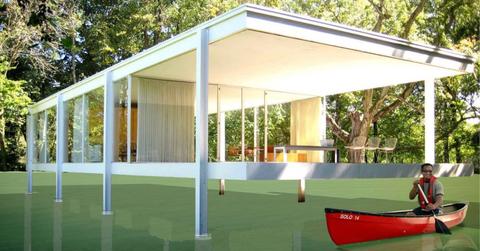Engineers Have Developed A System To Make Houses Float During Flooding
The Buoyancy Foundation Project is encouraging people in certain flood risk areas to consider retrofitting their homes with a foundation that floats, but its being met with resistance in the U.S. despite success in many communities around the world.
Updated Nov. 19 2020, 9:38 p.m. ET
Architects, designers, and other climate change researchers are always exploring new ways to deal with coastal flooding, from retrofitting entire cities to be flood proof to changing domestic building plans to account for weather events like hurricanes. On both large and small scales, people are adjusting their way of living, especially with the unprecedented number of storms and foods in the last year.
A former associate professor at the University of Waterloo named Elizabeth English has created an innovative way to account for floods in certain areas with her organization the Buoyant Foundation Project. The New Yorker reports that the BFP are promoting the concept of "amphibious buildings," or buildings that are designed for the land, but can self-adjust when water levels rise. Established in 2006, the BFP created their first prototype by 2007.
They chose a test house in New Orleans, fastening a steel frame around the underside of it. Affixed to that were foam blocks that provided the buoyancy in the name. Posts were then sunk into the ground at every corner of the house so it wouldn't float completely away if flooding occurred. They built a flood tank around the house to test it, then began to pump in water form the nearby river. The house floated.
“It was a religious experience when it lifted off,” English said.
Not only did it work, the process was relatively cheap and easy to do. It requires at least two people who know something about construction and some heavy equipment. It costs between $10 and $40 a foot to install, but is still two to three times less expensive than putting a house on permanent elevation. It's also relatively discrete, leaving the exterior of the house more or less unchanged. Permanent elevation is also worse for protecting a home against damages from the wind rather than water.
Like many innovations, it's not for every situation, like in an area susceptible to high speed waves.
“This is not a one-size-fits-all solution,” English said. “But it’s an excellent solution for some circumstances.”
And there's enough circumstances out there that demand solutions to flooding that has helped BFP grow. The company has produced lower cost versions for vulnerable populations in Nicaragua and Jamaica, and have been conversing with indigenous populations in coastal areas around Canada and in Louisiana. But in the U.S., amphibian structures also face challenges.
Areas in high-risk flood zones require homeowners to buy flood insurance, but subsidized policies from the National Flood Insurance Program are not available to anyone with an amphibious foundation. FEMA has officially stated that the process needs more research, and English says she has been met with a fair amount of derision when presenting her world. But she still gets commissions to build the foundation for homes outside of the U.S., and believes the tide is turning, in more ways than one.
